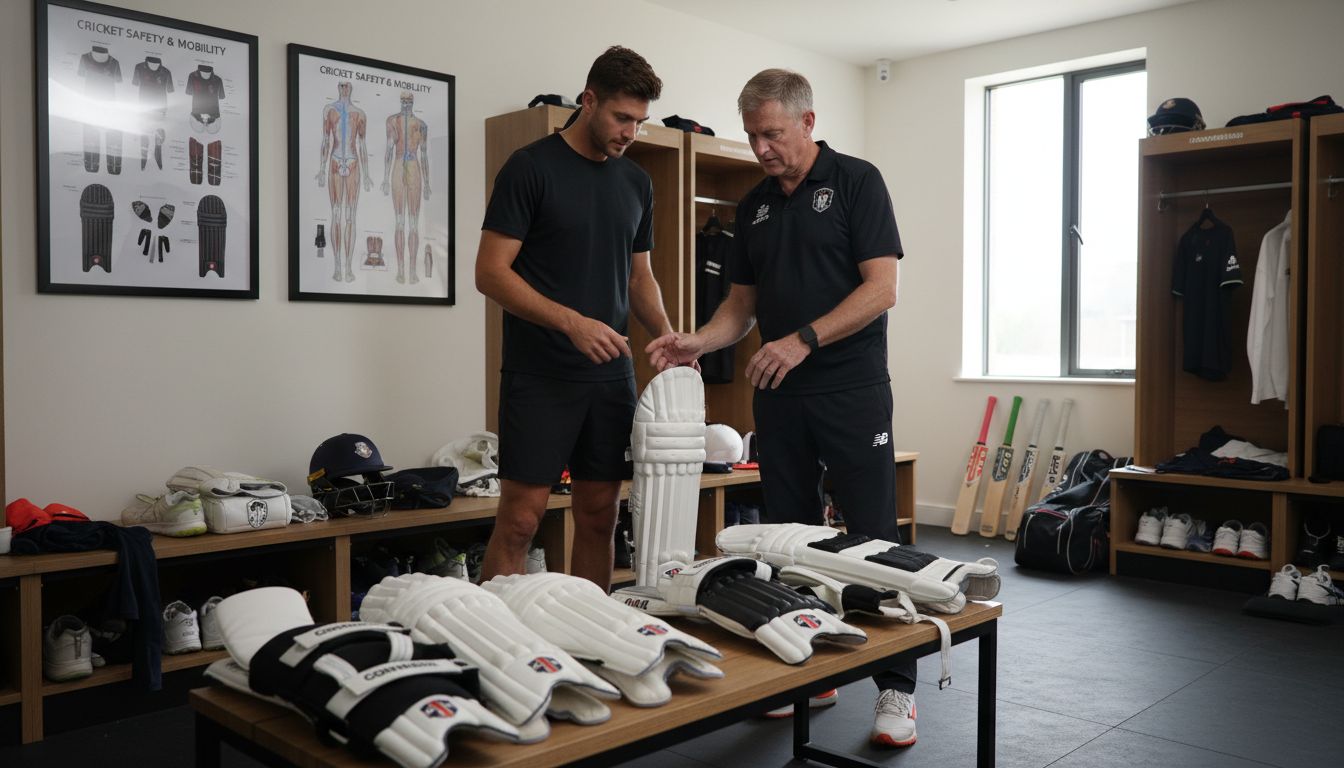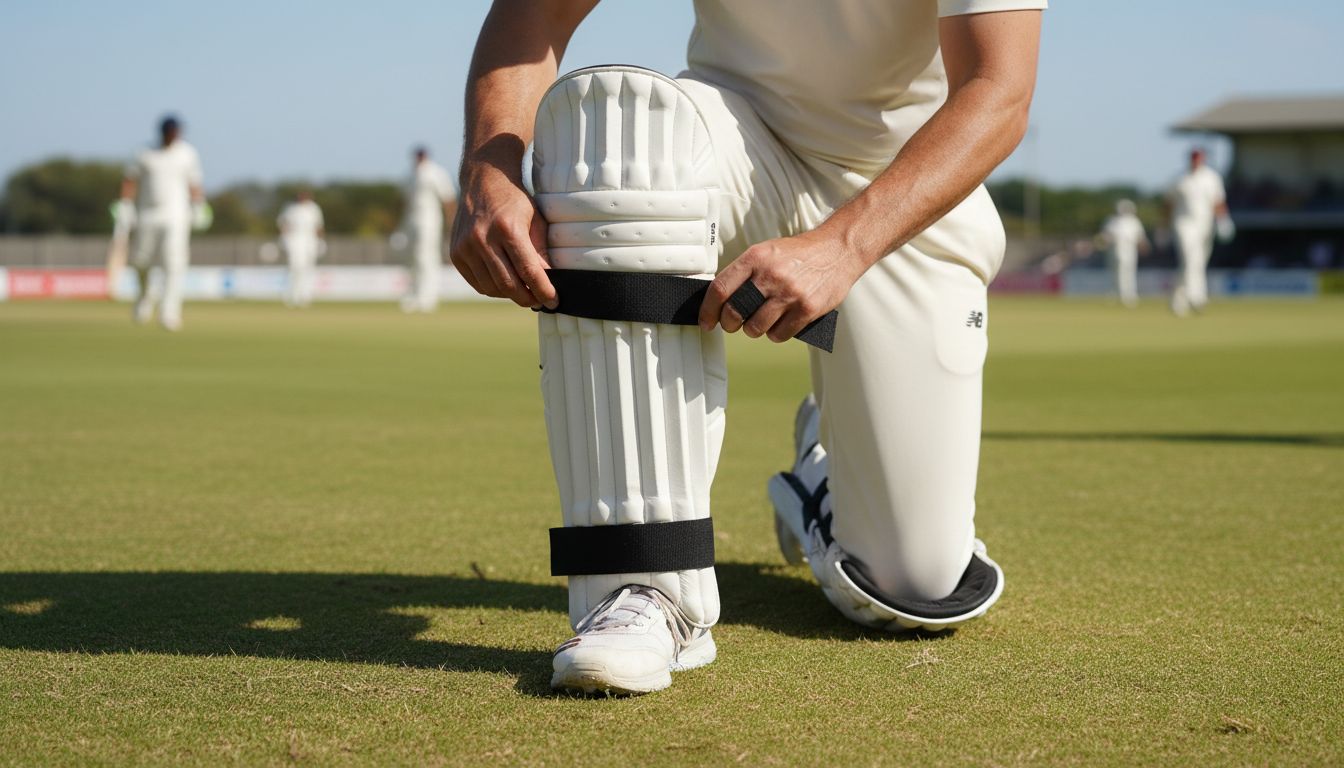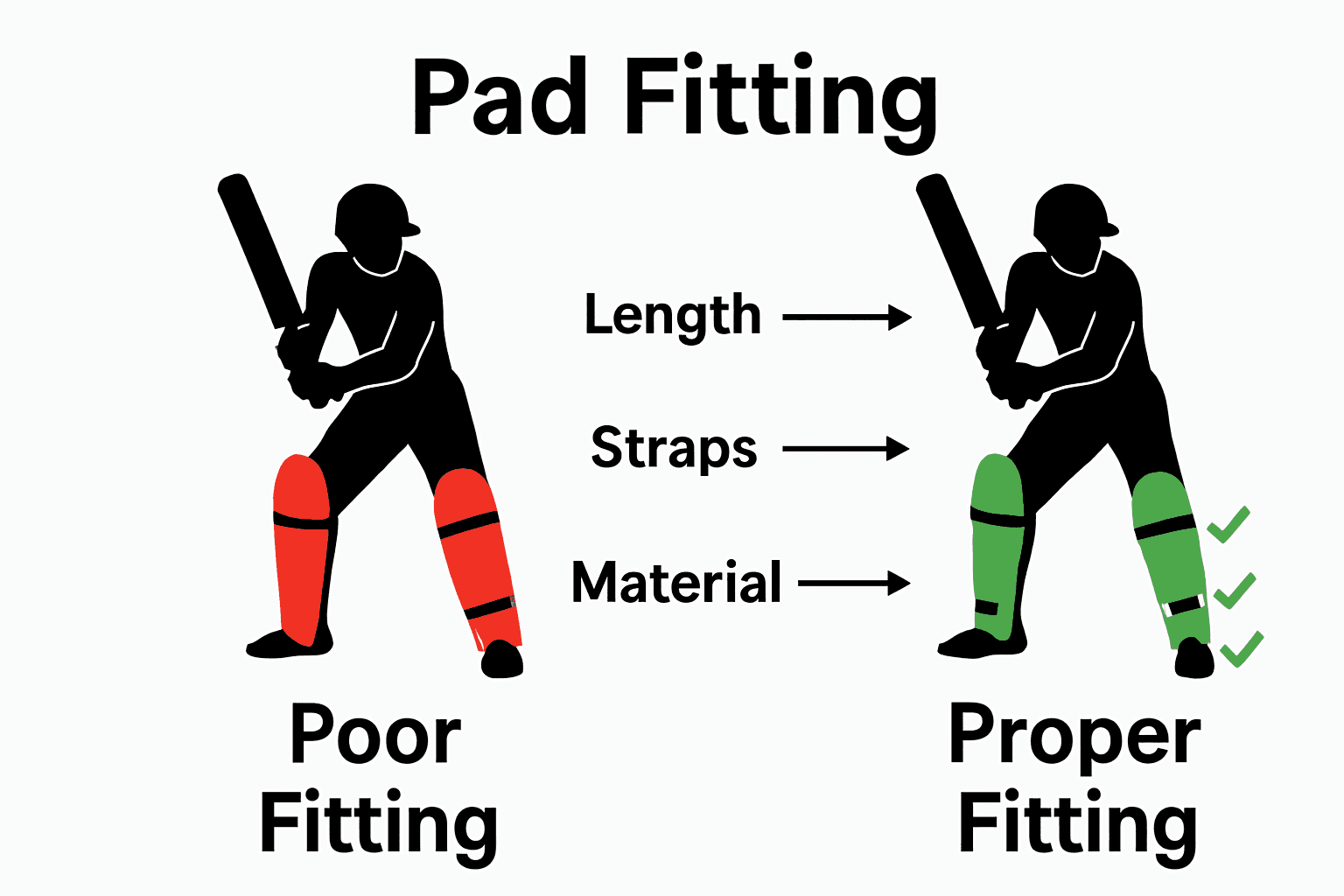Cricket Pads Fitting: Everything You Need to Know

Most american players assume cricket pads are a simple one-size solution, yet research shows that ill-fitting pads can slow running speed and heighten injury risk. With cricket’s growing popularity in the american community, understanding how to choose and fit pads becomes crucial for both safety and performance. This guide uncovers the biggest fitting misconceptions, explains key factors in pad selection, and reveals how smart choices can help players stay protected and agile on the field.
Table of Contents
- Cricket Pads Fitting Explained and Misconceptions
- Types of Cricket Pads and Key Differences
- Importance of Proper Pads Fitting for Players
- How to Achieve Optimal Pads Fit and Comfort
- Risks of Poor Fitting and Common Mistakes
Key Takeaways
| Point | Details |
|---|---|
| Proper Fit is Essential | Cricket pads must fit well to ensure player safety, enhance mobility, and improve performance. Ill-fitting pads can hinder movement and increase injury risk. |
| Types of Pads Matter | Different pads serve specific roles, such as batting, wicket-keeping, and fielding, requiring careful selection based on player position and style. |
| Material and Design Influence Comfort | Modern cricket pads incorporate advanced materials and ergonomic designs that enhance comfort, protection, and performance during play. |
| Common Fitting Mistakes to Avoid | Players often choose incorrect sizes or ignore personal anatomy, which can lead to discomfort and performance issues on the field. |
Cricket Pads Fitting Explained and Misconceptions
Cricket pads are more than just protective gear – they’re a critical component of a player’s equipment that directly impacts performance and safety. According to research from Monash University, ill-fitting pads can significantly compromise both player protection and athletic capabilities.
Common misconceptions about cricket pads often lead players to make poor equipment choices. Many believe that one-size-fits-all or that pads are purely about protection. In reality, proper pad fitting involves understanding your body mechanics, playing style, and specific defensive requirements. PubMed research highlights that incorrectly fitted pads can actually increase running time and restrict movement, potentially undermining a player’s overall performance.
To achieve optimal pad fitting, players should consider several key factors:
- Length: Pads should cover from just below the knee to the top of the shoe

- Width: Ensure full shin and lower leg coverage without excessive bulk
- Weight: Lighter pads improve mobility while maintaining protection
- Flexibility: Select pads that allow natural leg movement
- Material: Choose breathable, durable materials that offer both comfort and protection
Understanding these nuanced aspects of cricket pad selection goes beyond simple measurements. It requires a holistic approach that balances individual physique, playing position, and personal comfort. By dispelling myths and focusing on precision fitting, cricketers can significantly enhance their defensive capabilities and overall on-field performance.
Types of Cricket Pads and Key Differences
Cricket pads are far more sophisticated than simple protective equipment. PubMed research reveals significant advancements in pad technology, highlighting how modern designs now incorporate lightweight thermoplastic composites that dramatically improve player performance and comfort.
Typically, cricket pads can be categorized into several primary types based on their specific protective characteristics and intended use:
- Batting Pads: Designed for batsmen, offering maximum leg protection during innings
- Wicket-Keeper Pads: Shorter and more flexible, allowing enhanced mobility
- Fielding Pads: Lightweight options for fielders requiring quick movement
- Junior Pads: Sized specifically for younger players with growing physiques
- Professional-Grade Pads: High-performance options with advanced impact protection
According to insights from Kreedon, modern cricket pads distinguish themselves through innovative materials and specialized design features. Brands like Gray-Nicolls, SG, and Kookaburra now engineer pads that balance critical factors such as impact resistance, weight, breathability, and player-specific ergonomics.
The evolution of cricket pad design demonstrates a profound understanding that protection is not a one-size-fits-all solution. Players must consider their individual playing style, position, and physical requirements when selecting pads. By understanding these nuanced differences, cricketers can choose equipment that not only safeguards them but also enhances their on-field performance and comfort.
Importance of Proper Pads Fitting for Players
Cricket pad fitting is far more than a simple equipment adjustment – it’s a critical element of player performance and safety. PubMed research reveals that improperly fitted pads can significantly impede a player’s running performance, increasing the time taken to complete runs and potentially compromising overall athletic efficiency.
The implications of incorrect pad fitting extend well beyond mere inconvenience. According to Monash University, ill-fitting pads can lead to substantial risks, including:
- Increased Injury Potential: Poorly fitted pads fail to provide adequate protection
- Restricted Movement: Bulky or misaligned pads limit natural leg motion
- Performance Degradation: Incorrect pad sizing can slow down batting and fielding responses
- Comfort Compromise: Pads that don’t fit correctly can cause chafing and discomfort
- Reduced Confidence: Players feeling unprotected may hesitate during critical moments
Beyond physical protection, proper pad fitting plays a psychological role in a player’s performance. When cricketers feel secure and unrestricted, they can focus entirely on their game strategy, making split-second decisions without worrying about potential physical limitations. The right pad fit translates to enhanced mobility, improved reaction times, and a more confident approach to both batting and fielding.
Ultimately, selecting and fitting cricket pads is a nuanced process that requires careful consideration of individual body mechanics, playing style, and personal comfort. Check out our guide on cricket pads fitting to understand the intricate details of achieving the perfect pad fit that can transform your on-field performance.
How to Achieve Optimal Pads Fit and Comfort
PubMed research reveals groundbreaking insights into cricket pad design, highlighting how modern engineering has transformed pad fitting from a simple protective measure to a sophisticated ergonomic experience. Advanced materials now enable pads to conform precisely to a player’s leg shape, dramatically improving comfort and protection during extended play.
Achieving the perfect pad fit requires a systematic approach. According to Kreedon, players should focus on several critical fitting parameters:
- Length Check: Ensure pads cover from just below the knee to the top of the shoe
- Strap Adjustment: Secure straps snugly without creating circulation restrictions
- Knee Roll Positioning: Align knee roll centrally for maximum protection
- Lateral Movement Test: Verify pads allow full range of leg motion
- Weight Distribution: Confirm even weight across the leg for balanced comfort
The nuanced art of pad fitting goes beyond simple measurements. Players must consider their unique body mechanics, playing style, and individual comfort preferences. Professional cricketers understand that well-fitted pads are not just protective gear but an extension of their athletic performance – reducing injury risk while maximizing mobility and confidence on the field.
Ultimately, selecting the right cricket pads is a personal journey that combines scientific precision with individual comfort. For players seeking more detailed guidance on navigating this complex process, check out our comprehensive guide on cricket pad types to make an informed decision tailored to your specific needs.
Risks of Poor Fitting and Common Mistakes
PubMed research reveals a critical insight that many cricketers overlook: poorly fitted pads can dramatically compromise athletic performance. The study demonstrates that improper pad fitting can significantly slow running times, creating a cascading effect of reduced agility and increased player fatigue during critical match moments.
According to Monash University, cricketers frequently make several common mistakes when selecting and fitting pads:
- Incorrect Size Selection: Choosing pads too large or small for body type
- Strap Misalignment: Failing to adjust straps for proper leg coverage
- Neglecting Mobility: Selecting pads that restrict natural leg movement
- Ignoring Personal Anatomy: Not accounting for individual leg shape and size
- Overlooking Material Flexibility: Choosing rigid pads that limit performance
These mistakes carry significant consequences beyond mere discomfort. Ill-fitting pads can create vulnerable areas during play, increase injury risk, and psychologically undermine a player’s confidence.
 Professional cricketers understand that pad fitting is not just about protection, but about creating a seamless extension of the player’s body that supports peak performance.
Professional cricketers understand that pad fitting is not just about protection, but about creating a seamless extension of the player’s body that supports peak performance.
Navigating the complex world of cricket pad selection requires careful consideration and personalized approach. Check out our guide on understanding cricket pad types to help players make informed decisions that protect both their physical safety and competitive edge.
Find the Perfect Cricket Pads to Boost Your Performance and Safety
Proper cricket pad fitting is essential to protect yourself while maintaining agility and comfort on the field. If you want to avoid the common pitfalls of ill-fitting pads like restricted movement, increased injury risk, or slower running times, it’s time to choose gear designed with precision and your unique needs in mind. Whether you are a batsman, wicket-keeper, or fielder, the right pads can make a real difference in confidence and game performance.

Explore a wide selection of expertly crafted cricket pads at CricketKingdom.co.uk that combine advanced materials and ergonomic design for superior fit and protection. Take advantage of free shipment on orders over £100 and access detailed guides to ensure your pads fit perfectly. Don’t wait to enhance your game — start shopping now and experience the comfort and security only well-fitted cricket pads can provide. Discover more about how to get the best fit in our cricket pads fitting guide and explore different pad styles with our understanding types of cricket pads resource.
Frequently Asked Questions
How do I know if my cricket pads are the right size?
To ensure proper fit, cricket pads should cover from just below the knee to the top of the shoe. Make sure the width provides full shin coverage without excessive bulk and adjust straps for a snug fit without restricting circulation.
What are the different types of cricket pads available?
Cricket pads can be categorized into batting pads, wicket-keeper pads, fielding pads, junior pads, and professional-grade pads. Each type is designed for specific roles, offering tailored protection and mobility.
Why is it important to have well-fitted cricket pads?
Properly fitted pads enhance player protection, improve mobility, and boost overall performance. Ill-fitting pads can restrict movement, increase injury risk, and undermine a player’s confidence on the field.
What common mistakes should I avoid when fitting cricket pads?
Avoid selecting incorrect sizes, misaligning straps, choosing restrictive pads, ignoring your unique leg shape, and overlooking the flexibility of the material. These mistakes can lead to increased injury risk and hinder performance.
Recommended
- Cricket Pads Fitting Guide: Achieve Perfect Pad Fit Fast – The Cricket Kingdom
- Understanding the Types of Cricket Pads for Players – The Cricket Kingdom
- What Is a Thigh Pad? Complete Guide for Cricketers – The Cricket Kingdom
- Understanding Why Use Cricket Pads for Protection – The Cricket Kingdom


